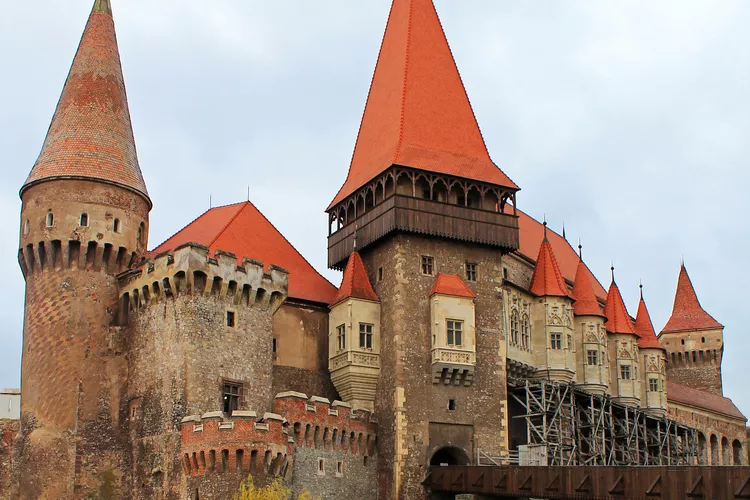Summary
Legends, Photos, and Visitor Information
Romania’s castles are alluring, not only for their haunting beauty but for the legends and history that surround them. For castles that are still standing, visitors can wander through the same halls and view the same natural landscapes that the inhabitants did while picturing themselves in a different time and place. Ruined castles represent a different type of beauty: ghosts linger in crumbled towers and fallen parapets. It’s up to the viewer to picture the castle intact, standing strong against sieges or providing sanctuary for influential families.
Peles Castle, Romania

Peles Castle, located near Sinaia in Romania, is known as one of the country’s most beautiful castles. Constructed at the end of the 19th and beginning of the 20th century, it was built for King Carol I of Romania. The castle served Romanian royalty until the end of the monarchy and was transformed into a museum in the early 1950s.
Peles Castle boasts luxurious interiors as stunning as its exterior. Guests can explore 35 of its over 150 rooms, which include an armory, the imperial suite, and sumptuously decorated rooms filled with furnishings from around the world. An additional fee is charged for photography, but bringing a camera to capture the beauty is highly recommended.
Dracula’s Bran Castle, Romania

Bran Castle is popularly known as Dracula’s Castle, yet the real Dracula, Vlad Tepes, never lived here. Although not one of Romania’s prettiest castles, its connection to the famous vampire legend makes Bran Castle one of the country’s top tourist attractions. The castle’s appeal lies in its intriguing history and accessibility.
Visitor interest in Dracula has driven the castle’s administrators to enhance its visitor experience. The Bran Castle offers English-language information about directions and other guidance for travelers to Romania and the Brașov region.
Visitors will uncover the connections between Bran Castle and Dracula, its significance as a medieval fortress, as well as intriguing historical facts.
The Culture Palace, Romania

A center of Romanian culture, the Culture Palace is situated in Lasi and houses four of the most significant museums in the country:
- The Museum of Art
- The Museum of History
- The Museum of Ethnography
- The Museum of Science and Technology
Fagaras Castle, Romania

Fagaras was built as a formidable fortress, and the town of Fagaras has developed around this medieval citadel. The castle’s thick brick walls and deep moat enabled it to withstand various sieges and attacks, making these features its most notable aspects.
Today, Fagaras Castle serves as a museum of archeology and history, preserving eighty of its rooms, along with towers and courtyards. Its well-preserved condition allows visitors to envision its historical role as a respected Transylvanian stronghold and military outpost.
Hunedoara or Corvin’s Castle, Romania

Hunedoara Castle, also known as Corvin’s Castle or Hunyadi Castle, is a 14th-century Gothic structure featuring a drawbridge and numerous towers. It is known as the place where Vlad Dracul, father of Vlad Tepes, was imprisoned for several years. Named after the Hunyadi family that owned it, the restored castle now operates as a museum showcasing archaeological finds and artifacts from its era.
Poenari Castle, Romania

Located near Targoviste, the ruins of Poenari Castle are sometimes referred to as Vlad Tepes’ palace. Vlad Tepes actually reconstructed Poenari Castle from older ruins during his reign, serving as a fortress for the infamous ruler, known later as the Impaler. Visitors aiming to reach Poenari Castle should prepare for a climb of nearly 1,500 steps, making it a demanding trip ideal for the fit and adventurous. However, for enthusiasts of the Dracula legend, the effort may be well worth it, offering stunning views of the surrounding landscape akin to how Vlad III would have surveyed his domain.
Suceava Fortress, Romania

Suceava Fortress, dating back to the 14th century and located in the Bucovina region of Moldavia, is a robust citadel that successfully repelled attacks from Ottoman invaders during its prime. Suceava Fortress is easily accessed from the town of Suceava, making it a great addition to the rich historical sites in Bucovina, which include the UNESCO-protected painted monasteries.
Coltesti Fortress, Romania

Coltesti Fortress, now in ruins, was a 13th-century castle in the Trascau Mountains of Romania. Throughout its history, the castle has undergone multiple reconstructions and destructions.
Rasnov Citadel, Romania

Rasnov Castle, a 14th-century fortress built by the Teutonic Knights, was designed to withstand invasions from the Turks and Tartars. More than just a military outpost, Rasnov served as a fortified village, offering essential resources for residents during prolonged sieges. The castle has undergone various reconstructions over the centuries and continues to be an important historical site in Romania’s Brasov County.
Enisala Castle, Romania

Enisala Castle was built in the early 14th century and is located in Romania’s Tulcea County. The castle ruins provide a glimpse into the region’s medieval past.
Neamt Castle, Romania

Neamt Citadel, also known as Neamt Castle or Neamt Fortress, is situated in Targu Neamt, in northern Romania. This historic site dates back to the 14th century and offers insight into Romania’s rich historical landscape.
Kendeffy Castle, Romania

Kendeffy Castle, also referred to as Santamaria Orlea Castle, is located in Hunedoara County. Although its origins date back to the Middle Ages, the present structure features Baroque details and functions as an inn, welcoming travelers and history enthusiasts alike.





